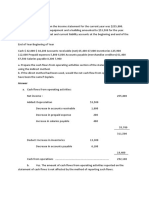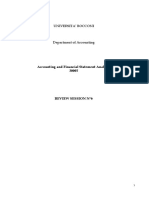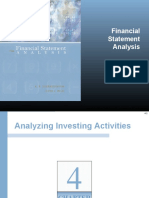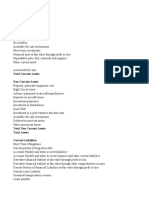ACCT10002 Tutorial 10 in-class Exercises
Uploaded by
d2701homeACCT10002 Tutorial 10 in-class Exercises
Uploaded by
d2701homeACCT10002: Tutorial 10 In-class Exercises
This tutorial provides exercises relating to the following areas of study:
Components of the Cash Flow Statement Construction of a Cash Flow Statement using
balance sheet and income statements
Reasons for identifying components of cash Direct and Indirect methods of constructing the
flows Cash Flow Statement
Students are required to prepare for all the questions prior to attending the tutorial.
1. (E11.1)
Wilderness Equipment Ltd had these transactions during 2015:
(a) Purchased a machine for $40 000, giving a long-term note in exchange.
(b) Issued ordinary shares for $62 500 in cash.
(c) Collected $20 000 of accounts receivable.
(d) Declared and paid a cash dividend of $31 250.
(e) Sold a long-term investment with a cost of $20 000 for $20 000 cash.
(f) Convertible notes with a carrying amount of $250 000 were converted to ordinary shares at
$250 000.
(g) Paid $24 000 on accounts payable.
Required:
(a) Analyse the above transactions and indicate whether each transaction resulted in a cash flow from
operating activities, investing activities, financing activities, or was a non-cash investing and fin-
ancing activity.
(b) What are the differences between operating, investing and financing activities?
2. (BE11.3)
Cheong’s Chinese Herbs Ltd has Accounts Receivable of $14 000 at 1 July 2015, and $24 000 at 30
June 2016. Sales revenues (all on credit) were $600 000 for 2016. Bad debts written off directly
against Accounts Receivable were $2000 in 2016.
Task: What is the amount of cash receipts from customers in 2016? Construct T accounts to
determine your answer.
3. (E11.7)
The income statement for Colin Ltd shows cost of sales $355 000 and operating expenses (exclusive
of depreciation) $230 000. The statement of financial position for the year shows that inventory
increased $6000, prepaid expenses decreased $6000, accounts payable (inventory suppliers) decreased
$8000, and accrued expenses payable decreased $12 000.
Required
Using the direct method, calculate:
(a) cash payments to suppliers and
(b) cash payments for operating expenses.
4. (BE11.4)
Pete’s Pies Ltd reports operating expenses of $216 000 excluding depreciation expense of $18 000 for
2015. The opening balance for Prepaid Insurance was $13,920 and the closing balance was $6,000.
Accrued Wages had an opening balance of $5,000 and the closing balance of this account was
$10,280.
Task: Calculate the cash payments for operating expenses in 2015 by constructing relevant T
accounts.
5. (PSA11.4)
These are the financial statements of Metro Meats Ltd:
METRO MEATS LTD
Statement of Financial Position
as at 31 December 2015
2015 2014
Assets
Cash $29 000 $15 000
Accounts receivable 28 000 14 000
Inventory 25 000 35 000
Property, plant and equipment 60 000 78 000
Accumulated depreciation (20 000) (24 000)
Total $122 000 $118 000
Liabilities and equity
Accounts payable $ 26 000 $ 25 000
Dividends payable 3 000 —
Income tax payable 5 000 8 000
Debentures payable 27 000 33 000
Share capital 18 000 14 000
Retained earnings 43 000 38 000
Total $122 000 $118 000
METRO MEATS LTD
Statement of Profit or Loss
for the year ended 31 December 2015
Sales $250 000
Cost of sales 210 000
Gross profit 40 000
Selling expenses 18 000
Administrative expenses 6 000
Interest expense 2 000
Profit before income tax 14 000
Income tax expense 4 000
Profit $ 10 000
The following additional data were provided:
1. The entity paid an interim dividend of $2 000 and declared a final dividend.
2. During the year equipment was sold for $8 500 cash. This equipment cost $18 000 originally and
had a carrying amount of $8 500 at the time of sale.
3. All depreciation expense is in the selling expense category.
4. All operating expenses except for depreciation were paid in cash.
Required
Prepare a statement of cash flows using the direct method.
You might also like
- Statement of Cash Flows - Lecture Questions and Answers88% (8)Statement of Cash Flows - Lecture Questions and Answers9 pages
- Statement of Cash Flows & Notes To Financial StatementsNo ratings yetStatement of Cash Flows & Notes To Financial Statements17 pages
- ACCT10002 Tutorial 10 in-class Exercises_SolutionsNo ratings yetACCT10002 Tutorial 10 in-class Exercises_Solutions6 pages
- 03 Course Notes On Statement of Cash Flows-2 PDFNo ratings yet03 Course Notes On Statement of Cash Flows-2 PDF4 pages
- Class 3 Statement of Cash Flows Learning Objectives: Financial Reporting and Analysis - Dr. Michael LeeNo ratings yetClass 3 Statement of Cash Flows Learning Objectives: Financial Reporting and Analysis - Dr. Michael Lee4 pages
- Statement of Cash Flows Lecture Questions and AnswersNo ratings yetStatement of Cash Flows Lecture Questions and Answers9 pages
- Statement of Cash Flows: Optional Assignment Characteristics TableNo ratings yetStatement of Cash Flows: Optional Assignment Characteristics Table11 pages
- 2020 Sem 1 ACC10007 Discussion Questions (And Solutions) - Topic 3No ratings yet2020 Sem 1 ACC10007 Discussion Questions (And Solutions) - Topic 36 pages
- Self-Learning Kit: Region I Schools Division of Ilocos Sur Bantay, Ilocos SurNo ratings yetSelf-Learning Kit: Region I Schools Division of Ilocos Sur Bantay, Ilocos Sur13 pages
- Chapter 2 Financial Statements Cash Flow and TaxesNo ratings yetChapter 2 Financial Statements Cash Flow and Taxes7 pages
- Statement of Cash Flows: Kimmel Weygandt Kieso Accounting, Sixth EditionNo ratings yetStatement of Cash Flows: Kimmel Weygandt Kieso Accounting, Sixth Edition43 pages
- Fundamental Managerial Accounting Concepts 9th Edition Edmonds Solutions Manual - Complete Set Of Chapters Available For One-Click Download100% (2)Fundamental Managerial Accounting Concepts 9th Edition Edmonds Solutions Manual - Complete Set Of Chapters Available For One-Click Download43 pages
- BINUS University Answer Sheet Accounting - Ariella HeliyawanNo ratings yetBINUS University Answer Sheet Accounting - Ariella Heliyawan5 pages
- Visual Financial Accounting for You: Greatly Modified Chess Positions as Financial and Accounting ConceptsFrom EverandVisual Financial Accounting for You: Greatly Modified Chess Positions as Financial and Accounting ConceptsNo ratings yet
- ACCT10002 Tutorial 1 Extra Practice Questions and SolutionsNo ratings yetACCT10002 Tutorial 1 Extra Practice Questions and Solutions7 pages
- ACCT10002 Tutorial 4 in-class Exercises_SolutionsNo ratings yetACCT10002 Tutorial 4 in-class Exercises_Solutions3 pages
- ACCT10002 Tutorial 5 Extra Practice Questions and SolutionsNo ratings yetACCT10002 Tutorial 5 Extra Practice Questions and Solutions8 pages
- ACCT10002 Tutorial 9 in-class Exercises_SolutionsNo ratings yetACCT10002 Tutorial 9 in-class Exercises_Solutions5 pages
- finance-for-the-non-financial-manager-exercisesNo ratings yetfinance-for-the-non-financial-manager-exercises121 pages
- Prof. Jon D. Inocentes, Cpa Lecture January 31, 2018No ratings yetProf. Jon D. Inocentes, Cpa Lecture January 31, 20188 pages
- The Common Forms of Debt Restructuring: Asset SwapNo ratings yetThe Common Forms of Debt Restructuring: Asset Swap5 pages
- The Following List of Accounts For Company Y Ltd. Is Available at The End of 200XNo ratings yetThe Following List of Accounts For Company Y Ltd. Is Available at The End of 200X2 pages
- Chap 6 - Financial Statements With Adjustment100% (1)Chap 6 - Financial Statements With Adjustment24 pages
- Bukalapak Com TBK Bilingual Q1 2023 FinalNo ratings yetBukalapak Com TBK Bilingual Q1 2023 Final175 pages
- Chapter 12, Modern Advanced Accounting-Review Q & Exr100% (5)Chapter 12, Modern Advanced Accounting-Review Q & Exr24 pages
- Immediate Download Solution Manual For Principles of Financial Accounting 11th Edition by Needles All Chapters100% (3)Immediate Download Solution Manual For Principles of Financial Accounting 11th Edition by Needles All Chapters50 pages






























































































